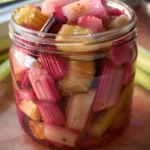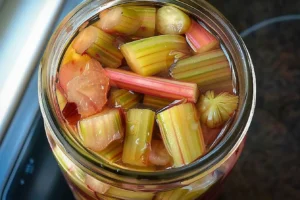Introduction to Homemade Rhubarb Pickles
Homemade rhubarb pickles offer a delightful twist on traditional pickling, combining a unique blend of tangy and sweet flavors that can enhance any meal. This detailed article will guide you through the entire process of making your own rhubarb pickles, from selecting the right rhubarb to the final steps of canning. Additionally, we will discuss the numerous health benefits of rhubarb, including its vitamin content and digestive health properties. You will also discover creative ways to incorporate these pickles into various dishes, whether as a condiment or a flavorful ingredient. Whether you are a seasoned pickler or a curious newcomer to the world of pickling, this guide provides you with comprehensive insights and practical tips to maximize your pickling journey.
What Makes Rhubarb Ideal for Pickling?
Rhubarb, with its firm texture and distinctively tart flavor, is ideally suited for pickling. This perennial plant, typically harvested in the spring, offers a wonderful opportunity to preserve the vibrant flavors of the season. When transformed into pickles, the natural sourness of rhubarb is perfectly balanced by a sweet and spicy brine. This creates a versatile condiment that can elevate a variety of dishes, from simple snacks to sophisticated entrees. Pickled rhubarb can add a delightful twist to salads, sandwiches, and even cocktails, making it a must-try for culinary enthusiasts looking to explore new flavors.
Essential Ingredients for Rhubarb Pickles
Creating the perfect rhubarb pickle involves carefully selecting and combining several key ingredients to achieve a balance of flavors and textures:
Rhubarb Stalks
The foundation of the pickle. Choose firm, fresh rhubarb stalks to ensure the pickles maintain a crisp texture. The freshness of the rhubarb is crucial as it directly affects the final texture and flavor of the pickles.
Vinegar
Acts as the pickling liquid. You can use white vinegar for a sharper taste or apple cider vinegar for a milder, slightly sweet flavor. Both types of vinegar are effective for creating a clear and flavorful brine that complements the natural tartness of the rhubarb.
Sugar
Essential for balancing the acidity of the vinegar. It enhances the natural sweetness of the rhubarb, mitigating the sharpness of the vinegar and making the overall flavor of the pickles more complex and palatable.
Spices
Mustard seeds, ginger, and cloves are typically used to add depth and warmth. Mustard seeds bring a subtle spiciness, ginger adds a fresh, piquant note, and cloves contribute a warm, aromatic quality. Together, these spices infuse the pickles with layers of flavor that elevate the simple combination of rhubarb, vinegar, and sugar.
These components, when combined correctly, result in a delightful rhubarb pickle that is tangy, sweet, and aromatic, with a pleasing texture that makes it a versatile accompaniment to many
Step-by-Step Guide to Making Rhubarb Pickles
Ingredients:
- 4 cups fresh rhubarb, cut into 1/2 inch pieces
- 1 cup white vinegar
- 1 cup sugar
- 1 cup water
- 2 teaspoons salt
- 1 teaspoon mustard seeds
- 1 teaspoon coriander seeds
- 1/2 teaspoon fennel seeds
- 4 cloves garlic, peeled
- 4 strips orange zest
Directions:
- In a saucepan, combine vinegar, water, sugar, and salt. Bring to a boil, stirring until the sugar and salt dissolve.
- Add mustard seeds, coriander seeds, fennel seeds, garlic, and orange zest to the boiling mixture.
- Place rhubarb pieces in a sterile jar.
- Pour the boiling liquid over the rhubarb, ensuring that the pieces are fully submerged.
- Allow to cool to room temperature, then seal the jar and refrigerate.
- Let the pickles sit for at least 24 hours before serving for the flavors to meld.
- Prep Time: 10 minutes | Cooking Time: 5 minutes | Total Time: 15 minutes plus chilling
- Kcal: 100 kcal per serving | Servings: 4 servings
Health Benefits of Rhubarb Pickles
Nutritional Profile of Rhubarb
Rhubarb, characterized by its low caloric content, is abundant in essential nutrients such as dietary fiber, vitamin C, and calcium. The process of pickling rhubarb not only extends its shelf life but also helps to retain many of these valuable nutrients. Consequently, rhubarb pickles offer a delectable taste and confer several health benefits, making them a nutritious addition to your diet. Consuming these pickles can contribute to your daily nutritional intake, supporting overall health and wellness.
Digestive Health Benefits
The dietary fiber found in rhubarb is highly beneficial for digestive health. It helps to regulate the digestive system by promoting regular bowel movements and preventing constipation. By maintaining a smooth and consistent digestive flow, rhubarb can aid in enhancing gut health and overall digestive efficiency. Incorporating rhubarb into your diet could be an effective way to support and improve your digestive health.

FAQs about Rhubarb Pickles
What ingredients are needed for homemade rhubarb pickles?
To make rhubarb pickles, you’ll need fresh rhubarb, vinegar, water, sugar, and a mix of spices such as cloves, cinnamon, and allspice.
How long does it take to pickle rhubarb?
The pickling process itself is quite quick, involving a brief simmer of just a few minutes to infuse the rhubarb with the flavors. However, the pickles should sit for several weeks to mature in flavor.
How should rhubarb pickles be stored?
After sealing in sterilized jars, store your rhubarb pickles in a cool, dark place like a pantry or cellar. This helps preserve their quality and enhances their flavors.
How long do rhubarb pickles last?
When stored properly, homemade rhubarb pickles can last for up to a year.
Can rhubarb pickles be used in cooking?
Yes, rhubarb pickles can be a delightful addition to many dishes. They can be used in salads, as a condiment for meats, or even blended into dressings and sauces for a tangy twist.
What are the health benefits of rhubarb pickles?
Rhubarb is low in calories but high in dietary fiber, vitamin C, and calcium. Pickling preserves many of these nutrients, making rhubarb pickles not only tasty but also beneficial for digestive health and overall well-being.
Conclusion to Homemade Rhubarb Pickles Guide
In this comprehensive exploration of homemade rhubarb pickles, we’ve delved into the captivating process that transforms the vibrant rhubarb into a jar of tangy-sweet delight. From selecting the freshest rhubarb to mastering the art of canning, this guide has equipped you with all the knowledge needed to create pickles that not only tantalize your taste buds but also contribute positively to your health.
The journey through the pickling process has highlighted rhubarb’s remarkable versatility and its substantial health benefits. Rich in vitamins and minerals, and particularly noted for its digestive health properties, rhubarb is more than just a pie ingredient—it’s a nutritional powerhouse that can revitalize and add a creative flair to your culinary creations.
As we’ve seen, rhubarb pickles can be incorporated into a myriad of dishes, from enhancing a simple salad to becoming a standout side that complements both sweet and savory dishes. The fusion of tangy and sweet flavors can elevate the most basic meals, turning them into something extraordinary.
Moreover, the art of pickling rhubarb yourself opens up a world of customization. Whether you prefer your pickles with a bit more bite or a softer sweetness, the techniques discussed here give you the control to tailor your pickles to your palate, making each batch uniquely yours.
In summary, whether you’re a seasoned pickler or a curious newcomer, the world of homemade rhubarb pickles offers a delightful culinary adventure. It’s a rewarding process that not only enhances your meals but also brings a sense of accomplishment and creativity to your cooking. So embrace the tangy-sweet journey of rhubarb pickling and let it inspire a new dimension of flavors in your kitchen. Happy pickling!

Rhubarb Pickles: A Tangy Delight in Every Bite
- Prep Time: 10 minutes
- Cook Time: 5 minutes
- Total Time: 15 minutes
Description
Rhubarb pickles are a tangy and sweet condiment made from fresh rhubarb, vinegar, sugar, and spices like ginger and mustard seeds. This crunchy pickle enhances salads, sandwiches, and platters with its vibrant flavor.
Ingredients
Ingredients:
4 cups fresh rhubarb, cut into 1/2 inch pieces
1 cup white vinegar
1 cup sugar
1 cup water
2 teaspoons salt
1 teaspoon mustard seeds
1 teaspoon coriander seeds
1/2 teaspoon fennel seeds
4 cloves garlic, peeled
4 strips orange zest
Instructions
Directions:
In a saucepan, combine vinegar, water, sugar, and salt. Bring to a boil, stirring until the sugar and salt dissolve.
Add mustard seeds, coriander seeds, fennel seeds, garlic, and orange zest to the boiling mixture.
Place rhubarb pieces in a sterile jar.
Pour the boiling liquid over the rhubarb, ensuring that the pieces are fully submerged.
Allow to cool to room temperature, then seal the jar and refrigerate.
Let the pickles sit for at least 24 hours before serving for the flavors to meld.
Prep Time: 10 minutes | Cooking Time: 5 minutes | Total Time: 15 minutes plus chilling
Kcal: 100 kcal per serving | Servings: 4 servings


